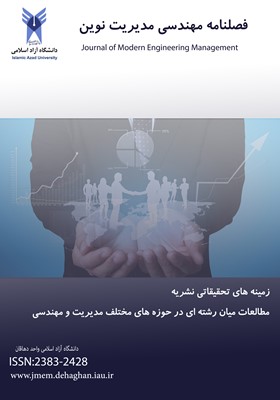پیش بینی پذیری بورس اوراق بهادار تهران با استفاده از مدل های یادگیری عمیق (مدل هیبریدی CNN-LSTM)
محورهای موضوعی : مدیریت مالی
مهدی حیدرزاده
1
,
مژگان صفا
2
*
![]() ,
میرفیض فلاح شمس
3
,
میرفیض فلاح شمس
3
![]() ,
حسین جهانگیرنیا
4
,
حسین جهانگیرنیا
4
![]()
1 - دانشجو دکتری مدیریت مالی، واحد قم، دانشگاه آزاد اسلامی، قم، ایران.
2 - استادیار گروه حسابداری، واحد قم، دانشگاه آزاد اسلامی، قم، ایران، (نویسنده مسئول).
3 - دانشیار گروه مدیریت، واحد تهران مرکزی، دانشگاه آزاد اسلامی، تهران، ایران.
4 - استادیار گروه حسابداری، واحد قم دانشگاه آزاد اسلامی، قم، ایران.
کلید واژه: پیش بینی پذیری, مدل های یادگیری عمیق, بورس اوراق بهادار تهران,
چکیده مقاله :
هدف: این تحقیق با هدف پیشبینی حرکت شاخص بورس اوراق بهادار تهران با استفاده از مدلهای یادگیری عمیق مبتنی بر شبکههای LSTM و CNN و ارائه یک مدل هیبریدی CNN-LSTM انجام شده است.
روششناسی پژوهش: استفاده از مدلهای یادگیری عمیق LSTM، CNN و مدل هیبریدی CNN-LSTM برای پیشبینی.استفاده از دادههای روزانه شاخص بورس اوراق بهادار تهران در بازه زمانی 23/4/1395 تا 26/1/1400. ارزیابی عملکرد مدلها با سه معیار سنجش کارایی SMAPE، MAPE و RMSE.
یافتهها: مدل هیبریدی CNN-LSTM بهترین عملکرد را در پیشبینی شاخص بورس اوراق بهادار تهران با گام یکروزه داشته است. مدل LSTM پس از مدل هیبریدی از نظر دقت و کارایی پیشبینی در رتبه دوم قرار میگیرد. استفاده از مدلهای تلفیقی یادگیری عمیق موجب افزایش کارایی و دقت پیشبینی در بازارهای مالی ایران میشود.
اصالت / ارزشافزوده علمی: ارائه و ارزیابی مدل هیبریدی CNN-LSTM برای اولین بار در پیشبینی شاخص بورس اوراق بهادار تهران.تأکید بر کاربرد مدلهای تلفیقی یادگیری عمیق بهعنوان رویکردی نوین در بهبود پیشبینی بازارهای مالی ایران.
Objective: This research aims to predict the movement of the Tehran Stock Exchange index using deep learning models based on LSTM and CNN networks and presenting a CNN-LSTM hybrid model.
Research methodology: Using LSTM, CNN, and CNN-LSTM deep learning models for prediction. Using daily data of the Tehran Stock Exchange index in the period from 23/4/1395 to 26/1/1400. Evaluating the performance of the models with three performance measurement criteria: SMAPE, MAPE, and RMSE.
Findings: The CNN-LSTM hybrid model has the best performance in predicting the Tehran Stock Exchange index with a one-day step. The LSTM model ranks second after the hybrid model in terms of accuracy and prediction efficiency. The use of deep learning hybrid models increases the efficiency and accuracy of prediction in Iranian financial markets.
Originality / Scientific Added Value: Presentation and evaluation of the CNN-LSTM hybrid model for the first time in predicting the Tehran Stock Exchange index. Emphasis on the use of deep learning fusion models as a new approach in improving the forecasting of Iranian financial markets.
Adebiyi, A. A., Adewumi, A. O., & Ayo, C. K. (2014). Comparison of arima and artifi- cial neural networks models for stock price prediction. Journal of Applied Math- ematics, 2014.#
Andrew Ang & Geert Bekaert (2007). "Stock Return Predictability: Is it There?" Review of Financial Studies, Society for Financial Studies, vol. 20(3), pages 651-707.#
Bollerslev, T., Marrone, J., Xu, L., & Zhou, H. (2014). Stock return predictability and variance risk premia: Statistical inference and international evidence. Journal of Financial and Quantitative Analysis, 49 (03), 633–661.#
Christopher Krauss; Xuan Anh Do and Nicolas Huck, (2017), Deep neural networks, gradient-boosted trees, random forests: Statistical arbitrage on the S&P 500, European Journal of Operational Research, 259, (2), 689-702.#
Gonçalves, R., Miguel,R. V, Pereira. F., Rocha. A., (2019). Deep learning in exchange markets. Information Economics and Policy.#
Kara, Y. and O. Baykan (2011). “Predicting Direction of Stock Price Index Changes Using Artificial Neural Networks and Support Vector Machines: The Sample of the Istanbul Stock Exchange”, Expert Systems with Applications, Vol. 36, No. 2, pp. 3355-3366.#
Krauss, C., Do, X. A., Huck, N. (2017). Deep neural networks, gradient-boosted trees, random forests: Statistical arbitrage on the S&P 500. European Journal of Operational Research 259(2), 689–702.#
R.C. Cavalcante, R.C. Brasileiro, V.L.F. Souza, J.P. Nobrega, A.L.I. Oliveira, (2016). Computational Intelligence and Financial Markets: A Survey and Future Directions, Expert Systems with Applications, 55,194-211.#
Tipirisetty, Abhinav, "Stock Price Prediction using Deep Learning" (2018). Master's Projects. 636. DOI: https://doi.org/10.31979/etd.bzmm-36m7.#
Tipirisetty, Abhinav, (2018). Stock Price Prediction using Deep Learning, Master's Projects. 636.#
Vadiei, Mohammad Hossein, & Hosseini, Seyyed Mohammad. (2012). The relationship between performance evaluation criteria and abnormal stock return. journal of empirical research in accounting, 1(4), 73-87. #
W. Long, Z. Lu and L. Cui, (2018). Deep learning-based feature engineering for stock price movement prediction, Knowledge-Based Systems .#
Yan, L.; Zhang, H. T.; Goncalves, J.; Xiao, Y.; Wang, M. et al. (2020): A machine learning-based model for survival prediction in patients with severe COVID-19 infection. MedRxiv: 2020.2002.2027.20028027#
Yang Liu, (2019). Novel Volatility Forecasting Using Deep Learning – Long Short Term Memory Recurrent Neural Networks, Expert Systems with Applications.#

